Contract Law Case Analysis: Enforceability of Promises and Offers
VerifiedAdded on 2023/05/31
|5
|943
|435
Case Study
AI Summary
This case study analyzes whether Empress can enforce Majestic's promise to sell her a silver sparkle slipper for $350 under contract law. It discusses the essential elements of a valid contract, including offer, acceptance, lawful object, free consent, and capacity of parties. The analysis differentiates between a valid offer and an invitation to treat, referencing relevant case law such as Hotchkiss v National City Bank of New York and Lefkowitz v. Great Minneapolis Surplus Store, Inc. The study concludes that Majestic's statement was an ambiguous invitation to treat rather than a definite offer, thus Empress cannot enforce the promise because no valid contract was formed. Desklib provides access to similar case studies and solved assignments for students.
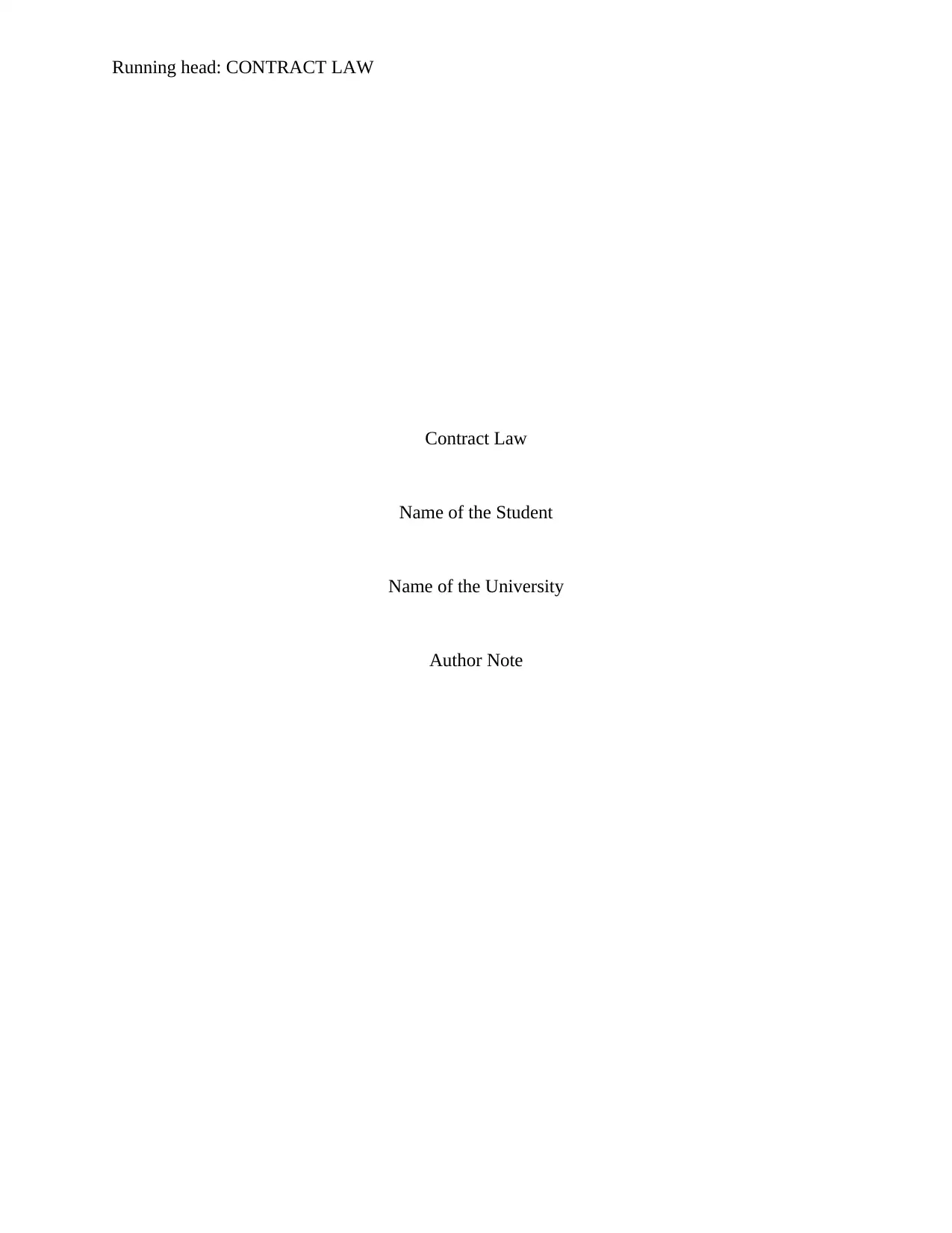
Running head: CONTRACT LAW
Contract Law
Name of the Student
Name of the University
Author Note
Contract Law
Name of the Student
Name of the University
Author Note
Paraphrase This Document
Need a fresh take? Get an instant paraphrase of this document with our AI Paraphraser
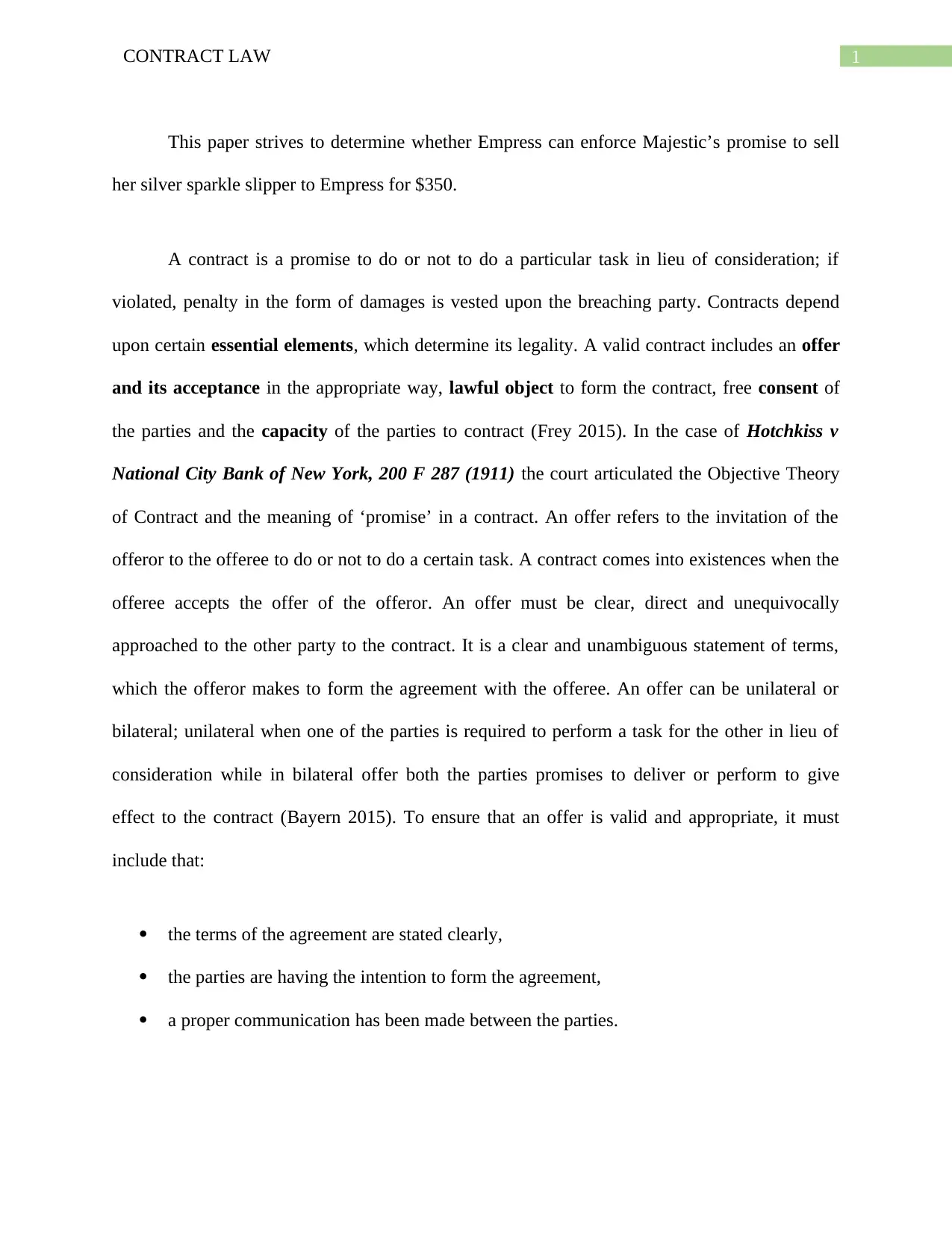
1CONTRACT LAW
This paper strives to determine whether Empress can enforce Majestic’s promise to sell
her silver sparkle slipper to Empress for $350.
A contract is a promise to do or not to do a particular task in lieu of consideration; if
violated, penalty in the form of damages is vested upon the breaching party. Contracts depend
upon certain essential elements, which determine its legality. A valid contract includes an offer
and its acceptance in the appropriate way, lawful object to form the contract, free consent of
the parties and the capacity of the parties to contract (Frey 2015). In the case of Hotchkiss v
National City Bank of New York, 200 F 287 (1911) the court articulated the Objective Theory
of Contract and the meaning of ‘promise’ in a contract. An offer refers to the invitation of the
offeror to the offeree to do or not to do a certain task. A contract comes into existences when the
offeree accepts the offer of the offeror. An offer must be clear, direct and unequivocally
approached to the other party to the contract. It is a clear and unambiguous statement of terms,
which the offeror makes to form the agreement with the offeree. An offer can be unilateral or
bilateral; unilateral when one of the parties is required to perform a task for the other in lieu of
consideration while in bilateral offer both the parties promises to deliver or perform to give
effect to the contract (Bayern 2015). To ensure that an offer is valid and appropriate, it must
include that:
the terms of the agreement are stated clearly,
the parties are having the intention to form the agreement,
a proper communication has been made between the parties.
This paper strives to determine whether Empress can enforce Majestic’s promise to sell
her silver sparkle slipper to Empress for $350.
A contract is a promise to do or not to do a particular task in lieu of consideration; if
violated, penalty in the form of damages is vested upon the breaching party. Contracts depend
upon certain essential elements, which determine its legality. A valid contract includes an offer
and its acceptance in the appropriate way, lawful object to form the contract, free consent of
the parties and the capacity of the parties to contract (Frey 2015). In the case of Hotchkiss v
National City Bank of New York, 200 F 287 (1911) the court articulated the Objective Theory
of Contract and the meaning of ‘promise’ in a contract. An offer refers to the invitation of the
offeror to the offeree to do or not to do a certain task. A contract comes into existences when the
offeree accepts the offer of the offeror. An offer must be clear, direct and unequivocally
approached to the other party to the contract. It is a clear and unambiguous statement of terms,
which the offeror makes to form the agreement with the offeree. An offer can be unilateral or
bilateral; unilateral when one of the parties is required to perform a task for the other in lieu of
consideration while in bilateral offer both the parties promises to deliver or perform to give
effect to the contract (Bayern 2015). To ensure that an offer is valid and appropriate, it must
include that:
the terms of the agreement are stated clearly,
the parties are having the intention to form the agreement,
a proper communication has been made between the parties.
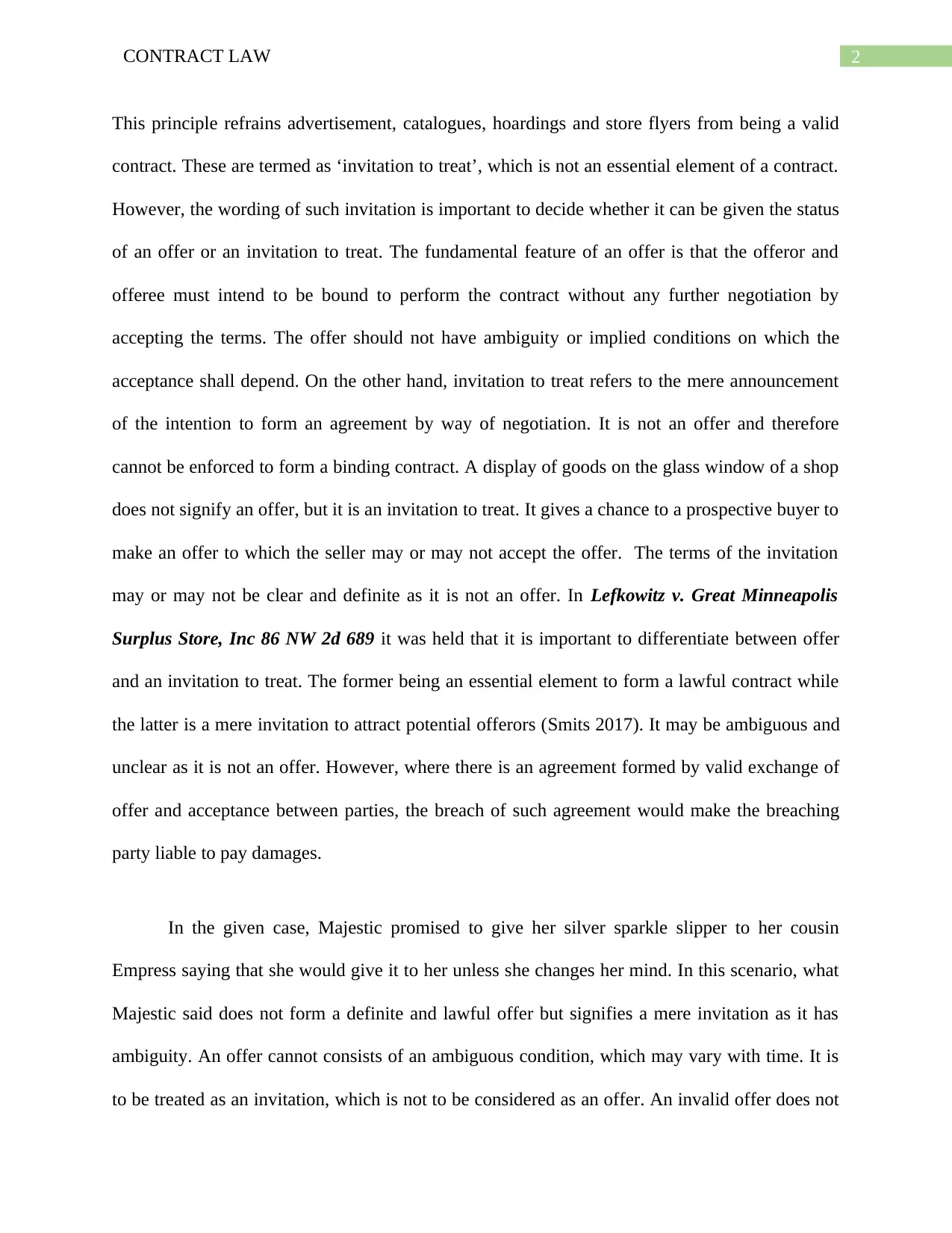
2CONTRACT LAW
This principle refrains advertisement, catalogues, hoardings and store flyers from being a valid
contract. These are termed as ‘invitation to treat’, which is not an essential element of a contract.
However, the wording of such invitation is important to decide whether it can be given the status
of an offer or an invitation to treat. The fundamental feature of an offer is that the offeror and
offeree must intend to be bound to perform the contract without any further negotiation by
accepting the terms. The offer should not have ambiguity or implied conditions on which the
acceptance shall depend. On the other hand, invitation to treat refers to the mere announcement
of the intention to form an agreement by way of negotiation. It is not an offer and therefore
cannot be enforced to form a binding contract. A display of goods on the glass window of a shop
does not signify an offer, but it is an invitation to treat. It gives a chance to a prospective buyer to
make an offer to which the seller may or may not accept the offer. The terms of the invitation
may or may not be clear and definite as it is not an offer. In Lefkowitz v. Great Minneapolis
Surplus Store, Inc 86 NW 2d 689 it was held that it is important to differentiate between offer
and an invitation to treat. The former being an essential element to form a lawful contract while
the latter is a mere invitation to attract potential offerors (Smits 2017). It may be ambiguous and
unclear as it is not an offer. However, where there is an agreement formed by valid exchange of
offer and acceptance between parties, the breach of such agreement would make the breaching
party liable to pay damages.
In the given case, Majestic promised to give her silver sparkle slipper to her cousin
Empress saying that she would give it to her unless she changes her mind. In this scenario, what
Majestic said does not form a definite and lawful offer but signifies a mere invitation as it has
ambiguity. An offer cannot consists of an ambiguous condition, which may vary with time. It is
to be treated as an invitation, which is not to be considered as an offer. An invalid offer does not
This principle refrains advertisement, catalogues, hoardings and store flyers from being a valid
contract. These are termed as ‘invitation to treat’, which is not an essential element of a contract.
However, the wording of such invitation is important to decide whether it can be given the status
of an offer or an invitation to treat. The fundamental feature of an offer is that the offeror and
offeree must intend to be bound to perform the contract without any further negotiation by
accepting the terms. The offer should not have ambiguity or implied conditions on which the
acceptance shall depend. On the other hand, invitation to treat refers to the mere announcement
of the intention to form an agreement by way of negotiation. It is not an offer and therefore
cannot be enforced to form a binding contract. A display of goods on the glass window of a shop
does not signify an offer, but it is an invitation to treat. It gives a chance to a prospective buyer to
make an offer to which the seller may or may not accept the offer. The terms of the invitation
may or may not be clear and definite as it is not an offer. In Lefkowitz v. Great Minneapolis
Surplus Store, Inc 86 NW 2d 689 it was held that it is important to differentiate between offer
and an invitation to treat. The former being an essential element to form a lawful contract while
the latter is a mere invitation to attract potential offerors (Smits 2017). It may be ambiguous and
unclear as it is not an offer. However, where there is an agreement formed by valid exchange of
offer and acceptance between parties, the breach of such agreement would make the breaching
party liable to pay damages.
In the given case, Majestic promised to give her silver sparkle slipper to her cousin
Empress saying that she would give it to her unless she changes her mind. In this scenario, what
Majestic said does not form a definite and lawful offer but signifies a mere invitation as it has
ambiguity. An offer cannot consists of an ambiguous condition, which may vary with time. It is
to be treated as an invitation, which is not to be considered as an offer. An invalid offer does not
⊘ This is a preview!⊘
Do you want full access?
Subscribe today to unlock all pages.

Trusted by 1+ million students worldwide
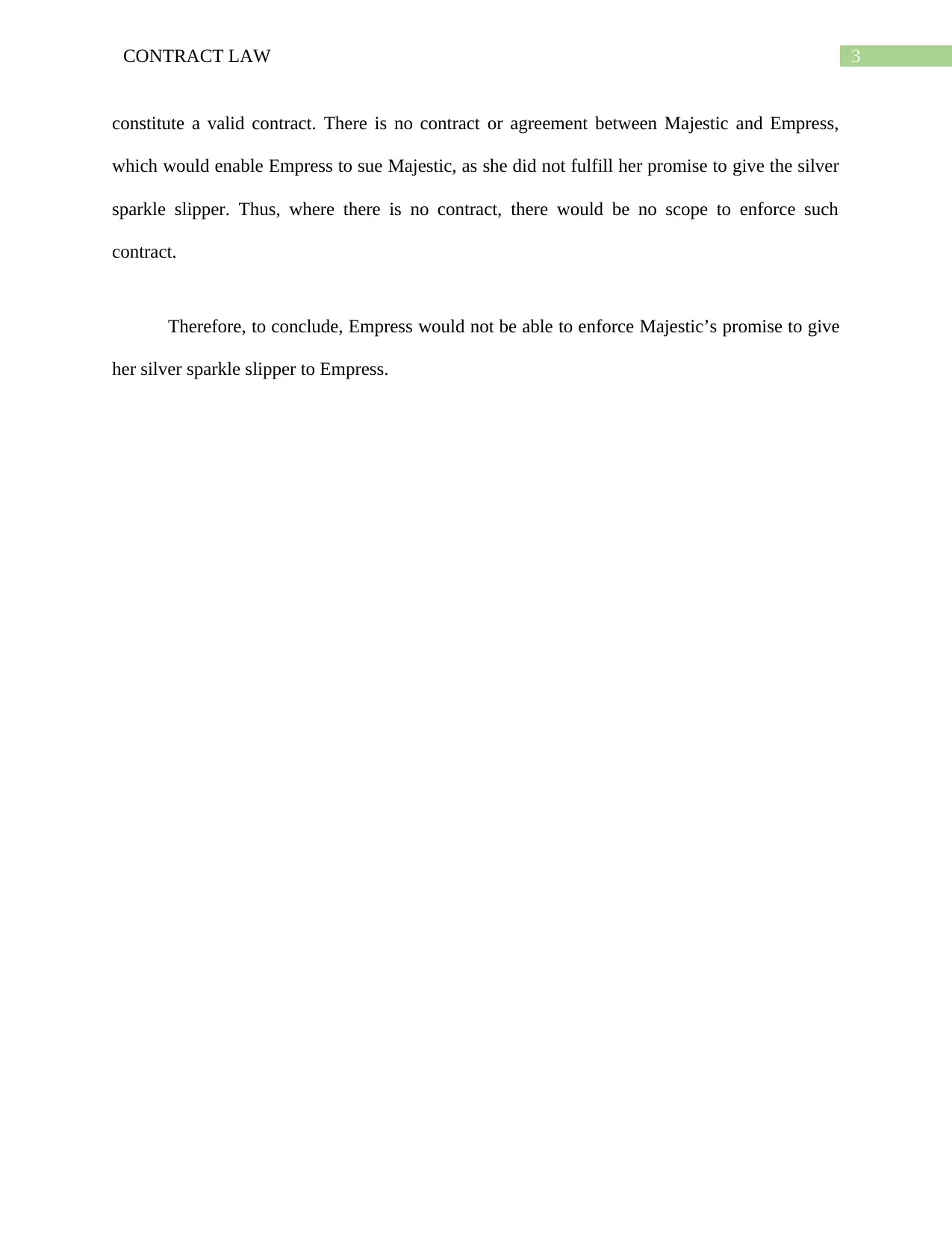
3CONTRACT LAW
constitute a valid contract. There is no contract or agreement between Majestic and Empress,
which would enable Empress to sue Majestic, as she did not fulfill her promise to give the silver
sparkle slipper. Thus, where there is no contract, there would be no scope to enforce such
contract.
Therefore, to conclude, Empress would not be able to enforce Majestic’s promise to give
her silver sparkle slipper to Empress.
constitute a valid contract. There is no contract or agreement between Majestic and Empress,
which would enable Empress to sue Majestic, as she did not fulfill her promise to give the silver
sparkle slipper. Thus, where there is no contract, there would be no scope to enforce such
contract.
Therefore, to conclude, Empress would not be able to enforce Majestic’s promise to give
her silver sparkle slipper to Empress.
Paraphrase This Document
Need a fresh take? Get an instant paraphrase of this document with our AI Paraphraser
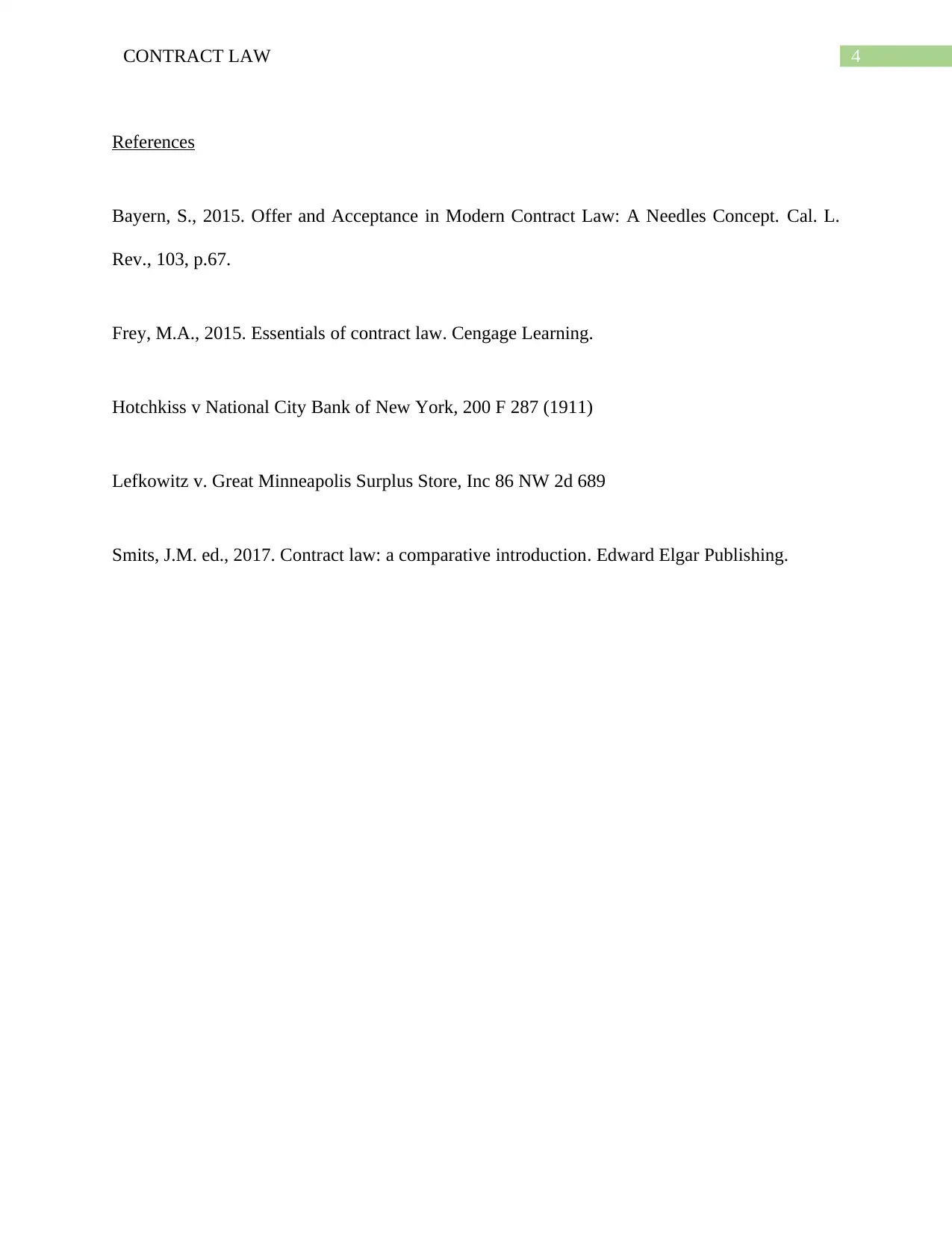
4CONTRACT LAW
References
Bayern, S., 2015. Offer and Acceptance in Modern Contract Law: A Needles Concept. Cal. L.
Rev., 103, p.67.
Frey, M.A., 2015. Essentials of contract law. Cengage Learning.
Hotchkiss v National City Bank of New York, 200 F 287 (1911)
Lefkowitz v. Great Minneapolis Surplus Store, Inc 86 NW 2d 689
Smits, J.M. ed., 2017. Contract law: a comparative introduction. Edward Elgar Publishing.
References
Bayern, S., 2015. Offer and Acceptance in Modern Contract Law: A Needles Concept. Cal. L.
Rev., 103, p.67.
Frey, M.A., 2015. Essentials of contract law. Cengage Learning.
Hotchkiss v National City Bank of New York, 200 F 287 (1911)
Lefkowitz v. Great Minneapolis Surplus Store, Inc 86 NW 2d 689
Smits, J.M. ed., 2017. Contract law: a comparative introduction. Edward Elgar Publishing.
1 out of 5
Related Documents
Your All-in-One AI-Powered Toolkit for Academic Success.
+13062052269
info@desklib.com
Available 24*7 on WhatsApp / Email
![[object Object]](/_next/static/media/star-bottom.7253800d.svg)
Unlock your academic potential
Copyright © 2020–2025 A2Z Services. All Rights Reserved. Developed and managed by ZUCOL.



